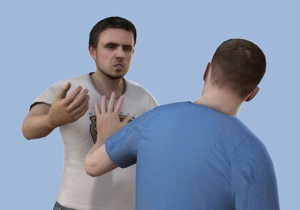A magazine where the digital world meets the real world.
On the web
- Home
- Browse by date
- Browse by topic
- Enter the maze
- Follow our blog
- Follow us on Twitter
- Resources for teachers
- Subscribe
In print
What is cs4fn?
- About us
- Contact us
- Partners
- Privacy and cookies
- Copyright and contributions
- Links to other fun sites
- Complete our questionnaire, give us feedback
Search:
Stirring up virtual trouble

What would you do if you saw someone getting beaten up? Would you jump in? Call for help? Is it possible you wouldn’t do anything? Social scientists have found that people don’t always help others, even if they realise someone’s in trouble. The only way to figure out why this happens, and what makes a difference whether bystanders help someone, is to study situations like it. But how? Scientists can’t just go around beating people up to see how others will react.
A team of computer scientists may have the answer: use virtual reality. The team includes researchers in the UK and Spain, one of whom is Richard Southern at Bournemouth University. Richard explains that by donning 3D glasses and stepping into a room with animations projected on the walls and floor, subjects can test their reactions without anyone getting hurt. "While people know it’s not real," Richard says, "they behave as if it is real."
You lookin' at me?
When you step into the illusion, you step into a pub. The team has designed an experiment in which the user is hanging around in a virtual pub when a character approaches him or her and begins talking about football. After a short conversation the character goes away, but soon he gets himself into trouble. Another character goes up to the friendly one and tries to stir up a fight. The user doesn’t know it, but this is the part the scientists are watching. What does the user do? Will he or she intervene?
It turns out that almost half do, but most don’t. Eleven out of twenty-five bystanders in the experiment so far have intervened. Some people in the virtual room reach out to try and touch the characters, while others try speaking to the tough guy to try and calm him down. Still others try looking around the room, to see whether the barman will catch on or if there’s someone else they can get to help. Many, though, just try and stay out of the way.

Friendly with Arsenal
Scientists are trying to figure out what makes the difference between whether people try and help, or decide to mind their own business. One of their theories is that it can depend on how much togetherness the subject feels with the character in trouble. Richard explains some studies have shown that "being a member of a particular group – generally groupiness – is a factor in determining the likelihood of intervention in violent emergencies." If the person feels like they share a bond, that feeling might prompt him or her to step in. That’s why one of the elements of the experiment was about togetherness. Sometimes when the user went into the virtual pub, the friendly character wore an Arsenal shirt, and sometimes he didn’t. The idea is that if the experimental subject is an Arsenal supporter, they might have a better chance of stepping in.
The unreal world
The illusion of reality might make the difference between helping and not helping too. That’s the bit Richard and his group at Bournemouth are particularly interested in. He explains that people will generally believe the illusion until they’re given a reason not to – say, if the user finds out they can walk through another character. In the bar fight, some of the users said they didn’t intervene because they didn’t think the virtual setting would let them. But even small issues with the realism of the animation might affect whether people intervene. Richard explains that the original experiment featured pretty basic animations, "and there were complaints about it from several of the bystanders – they said the animations were unrealistic." But Richard’s team doesn’t actually know if that changes the results of the experiment, or, if they do, by how much. So they’re going to try improving the animations and seeing if people react differently.
Helping out
There are a few good things that could come out of all this research. For one, Richard explains, their results could help in dangerous situations in the real world because "it might benefit the emergency services to know what to look for on CCTV cameras, for example", or finding out ways to help make it more likely that bystanders will intervene when something unpleasant happens.
Of course one big benefit of this research is that with every experiment done in a virtual environment, Richard explains that scientists have a chance to confirm that virtual experiments get good results. Plus, he says, “you can avoid the ethical issues of exposing people to violence and other dangerous situations". Which means that it’s possible to do experiments that couldn’t have been done without virtual reality. And you can rest easy knowing that there won’t be any wandering gangs of scientists on the street looking to start a fight. Not that you were worried about that before, of course.


